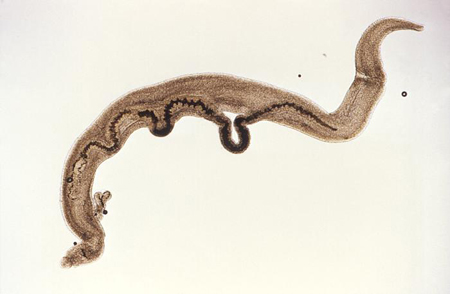Etiology
Schistosoma species and host animals have co-evolved. Six Schistosoma species can infect humans and produce chronic illnesses (S haematobium, S mansoni, S intercalatum, S guineensis, S japonicum, and S mekongi), but other Schistosoma species are specific for other host animals and intermediate snails. The predominant causative organisms of human infection are S haematobium,S japonicum, and S mansoni.[7][8]
Transmission of Schistosoma species depends on a complex life cycle that requires an intermediate freshwater snail host and exposure to contaminated freshwater on the part of the definitive human host.[15] In the case of S japonicum, the transmitting snails are amphibious, and infectious cercariae may be found in water beaded on wet grass or other vegetation near water. Schistosome eggs are excreted in human urine or feces. When eggs reach freshwater, they hatch into motile miracidia, which in turn infect susceptible species of snails.
Over several weeks, the miracidium develops asexually into multiple cercariae, which are then released from the snail, swimming through water to penetrate human skin.[3] In humans, the cercariae transform into schistosomula, which mature as they enter the bloodstream and migrate through the lungs and liver. Mature adult male and female worm pairs preferentially reside in a venous plexus (for S haematobium, it is the veins draining the ureters and bladder; for S mansoni, the superior mesenteric veins draining the large intestine; for S japonicum, the superior mesenteric veins draining the small intestine).
Worm maturation takes approximately 6 to 8 weeks; they then produce hundreds of eggs daily, approximately half of which ulcerate across host tissues to reach the lumen of the intestine or bladder, to be eliminated with feces or urine. Freshwater contamination by sewage perpetuates the Schistosoma life cycle. Adult worms live, on average, for 3 to 10 years in a human host, but can survive for as long as 40 years.[16][17][18]
[Figure caption and citation for the preceding image starts]: Cercariae of Schistosoma mansoni: indirect fluorescent antibody stainCDC, Dr Sulzer; used with permission [Citation ends].
Pathophysiology
Schistosomiasis is primarily a chronic disease, and some established infections cause only minimal symptoms. After human contact with contaminated water, larvae penetrating the human skin can cause cercarial dermatitis (especially S haematobium and S mansoni), causing localized inflammation and pruritus for several days or weeks.[11][19] After this initial stage, infected people may remain asymptomatic. Some people develop symptoms of snail fever or Katayama syndrome 1 to 2 months after exposure, particularly during primary S mansoni or S japonicum infection.[20] Patients may experience fever, headache, myalgia, abdominal pain, diarrhea, or cough as larvae migrate through tissues to develop in the bloodstream. Disease development and patient symptoms are caused by the host immune response to the eggs deposited into tissues rather than to the adult worms.[1] Hypersensitivity to initial egg deposition can result in urticaria, generalized pruritus, rash, or facial edema. Eosinophilia is common at this time.
Chronic infection presents a range of possible symptoms, from anemia and malnutrition to obstructive uropathy or portal hypertension. Iron loss and chronic inflammation contribute to anemia and malnutrition.[21][22] Pathology caused by immune-mediated inflammatory granulomas formed around parasite eggs trapped in host tissues leads to fibrosis, obstruction, and dysfunction of the affected organ.[23] Rarely, ectopic eggs in the CNS can result in cerebral masses or transverse myelitis with flaccid paralysis.[24][25] Chronic inflammation of the bladder can lead to cancer.[26]
Classification
Taxonomy and clinical manifestations
Six species of Schistosoma infect humans:
S haematobium causes urinary schistosomiasis
S mansoni, S intercalatum, S guineensis, S japonicum, and S mekongi cause intestinal schistosomiasis.
Clinical stages of infection
Cercarial dermatitis (swimmer's itch)
Occurs several days or weeks after exposure.
Transient pruritic dermatitis caused by entry of cercariae into skin.
Acute schistosomiasis (Katayama syndrome)
Occurs weeks after exposure; more common in travelers or new immigrants to the endemic area.
Causes systemic symptoms such as fever, fatigue, cough, abdominal pain and diarrhea, and transient hepatosplenomegaly.
Chronic schistosomiasis
Adult worms can survive for up to 20 years in a human host.
Granulomatous inflammation and fibrosis results in the area of the body where the parasites localize.
Use of this content is subject to our disclaimer